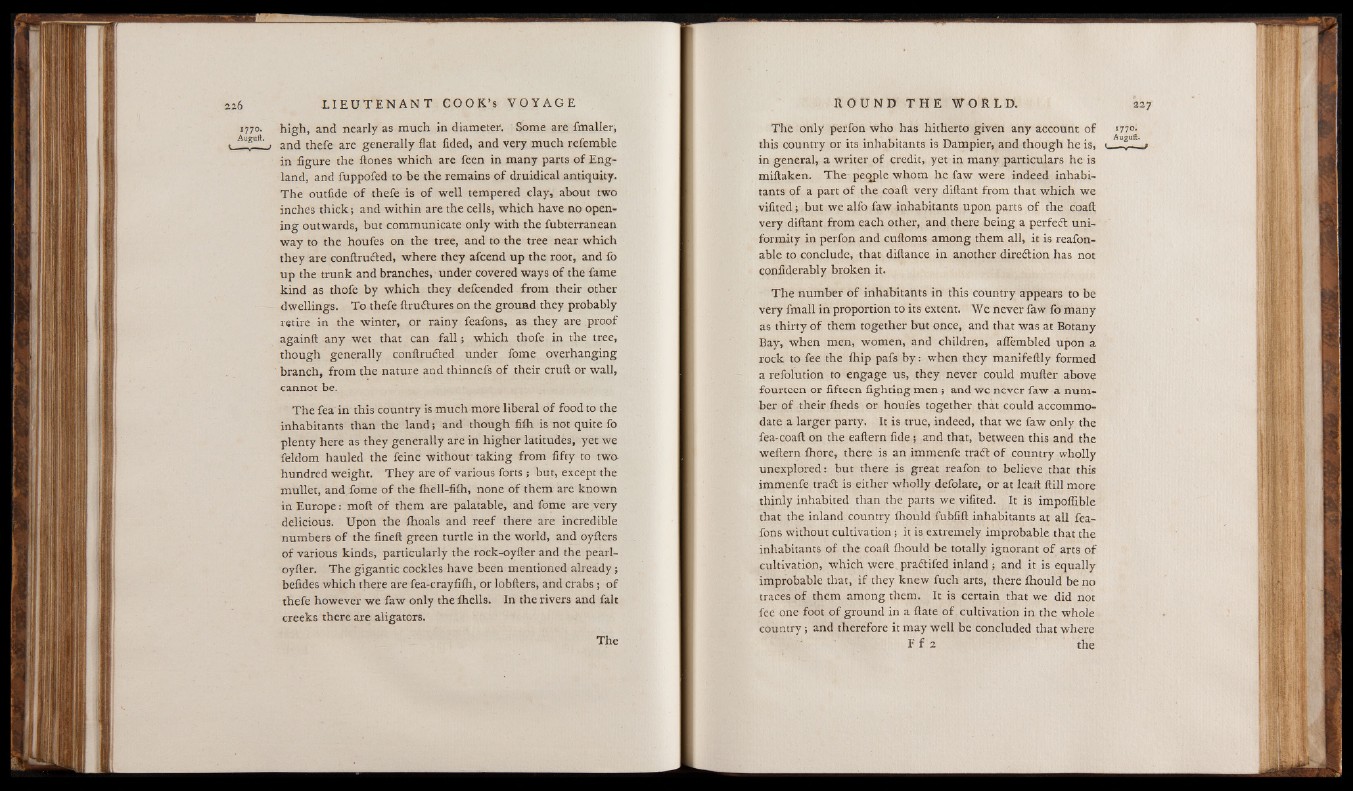
770. high, and nearly as much in diameter. Some are fmaller,
uguft' . and thefe are generally flat fided, and very much referable
in figure the ftones which are feen in many parts of England,
and fuppofed to be the remains of druidical antiquity.
The outfide of thefe is of well tempered clay, about two
inches thick; and within are the cells, which have no opening
outwards, but communicate only with the fubterranean
way to the houfes on the tree, and to the tree near which
they are conftrufted, where they afcend up the root, and fo
up the trunk and branches, under covered ways of the fame
kind as thofe by which they defcended from their other
dwellings. To thefe ftruftures on the ground they probably
retire in the winter, or rainy feafons, as they are proof
againft any wet that can fa ll; which thofe in the tree,
though generally conftrufted under fome overhanging
branch, from the nature and thinnefs of their cruft or wall,
cannot be.
The fea in this country is much more liberal of food to the
inhabitants than the land; and though fifh is not quite fo
plenty here as they generally are in higher latitudes, yet we
feldom hauled the feine without" taking from fifty to two
hundred weight. They are of various forts ; but, except the
mullet, and fome of the fliell-fifh, none of them are known
in Europe: moft of them are palatable, and fome are very
delicious. Upon the fhoals and reef there are incredible
numbers of the fineft green turtle in the world, and oyfters
of various kinds, particularly the rock-oyfter and the pearl-
oyfter. The gigantic cockles have been mentioned already ;
befides which there are fea-crayfifh, or lobfters, and crabs; of
thefe however we faw only the fhells. In the rivers and fait
creeks there are aligators.
The
The only perfon who has hitherto given any account of
this country or its inhabitants is Dampier, and though he is,
in general, a writer of credit, yet in many particulars he is
miftaken. The~ peqple whom he faw were indeed inhabitants
of a part of the coaft very diftant from that which we
vifited; but we alfo faw inhabitants upon parts of the coaft
very diftant from each other, and there being a perfeft uniformity
in perfon and cuftoms among them all, it is reafon-
able to conclude; that diftance in another direftion has not
confiderably broken it.
1770.
Auguft.
The number of inhabitants in this country appears to be
very fmall in proportion to its extent. We never faw fo many
as thirty of them together but once, and that was at Botany
Bay, when men, women, and children, aflembled upon a
rock to fee the fhip pafs b y : when they manifeftly formed
a refolution to engage us, they never could mufter above
fourteen or fifteen fighting men; and we never faw a number
of their Iheds or houfes together that could accommodate
a larger party. It is true, indeed, that we faw only the
fea-coaft on the eaftern fide; and that, between this and the
weftern fhore, there is an immenfe traft of country wholly
unexplored: but there is great reafon to believe that this
immenfe traft is either wholly defolate, or at leaft ftill more
thinly inhabited than the parts we vifited. It is impoflible
that the inland country fhould fubfift inhabitants at all feafons
without cultivation; it is extremely improbable that the
inhabitants of the coaft fhould be totally ignorant of arts of
cultivation, which were, praftifed inland ; and it is equally
improbable that, if they knew fuch arts, there fhould be no
traces of them among them. It is certain that we did not
fee one foot of ground in a ftate of cultivation in the whole
country; and therefore it may well be concluded that where
F f 2 the